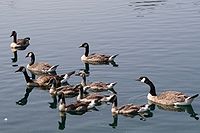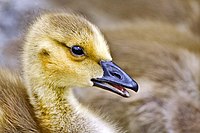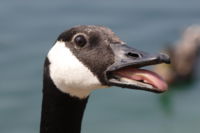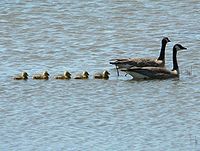Difference between revisions of "Field Guide/Birds/Branta canadensis"
| Line 67: | Line 67: | ||
==Outside North America== | ==Outside North America== | ||
| − | [[ | + | [[ |
| − | |||
| − | |||
| − | |||
| − | |||
| − | |||
| − | |||
| − | |||
==See also== | ==See also== | ||
Revision as of 17:38, 6 March 2007
- For the Canadian outerwear manufacturer Canada Goose see Canada Goose (clothing)
The Canada Goose (Branta canadensis) belongs to the Branta genus of geese, which contains species with largely black plumage, distinguishing them from the grey species of the Anser genus.
The species name, canadensis, is a New Latin word meaning "of Canada".
Appearance
The black head and neck with white "chinstrap" distinguish this goose from all except the Barnacle Goose, but the latter has a black breast, and grey, rather than brownish, body plumage. There are seven subspecies of this bird, of varying sizes and plumage details, but all are recognizable as Canada Geese. Some are hard to distinguish from the Cackling Goose (Branta hutchinsii), with which the Canada Goose was long assumed to form one species; the name Lesser Canada Goose is, confusingly, often applied to B. hutchinsii.
This species is 90-100 cm long with a 160-175 cm wing span. Males weigh 3.5–6.5 kg, (8–14 pounds), and can be very aggressive in defending territory. The female looks virtually identical but is slightly lighter at 3–5.5 kg (7–12 pounds), and has a different honk. Exceptionally, weights of 11.3 kg (25 pounds) and a wingspan of 224 cm (88 inches) have been recorded in the largest race.
Behaviour and habitat

These birds feed mainly on plant material. When feeding in water, they submerge their heads and necks to reach aquatic plants, sometimes tipping forward like a dabbling duck. Flocks of these birds often feed on leftover cultivated grains in fields, especially during migration or in winter.
During the second year of their lives, Canada Geese find themselves a mate. Most couples stay together all of their lives. If one is killed, the other may find a new mate. The female lays 4-8 eggs and both parents protect the nest while the eggs incubate, but the female spends more time at the nest than the male. During that time, they lose their flight feathers, so that they cannot fly until after their eggs hatch. This period lasts for 25-28 days.
Adult geese are often seen leading their goslings in a line, usually with one parent at the front, and the other at the back of the "parade". While protecting their young, parents often violently chase away nearby creatures, from small blackbirds to other geese, to humans that approach, after warning them by giving off a hissing sound.. However, geese may form groups of a number of goslings and a few adults, called crèches. The young do not leave their parents until after the spring migration, when they return to their birthplace.
This well-known species is native to North America. It breeds in Canada and the northern United States in a variety of habitats. However, the nest is usually located in an elevated area near water, sometimes on a beaver lodge. The eggs are laid in a shallow depression lined with plant material and down. The Great Lakes region maintains a very large population of Canada Geese.
Like most geese, the Canada goose is naturally migratory with the wintering range being most of the United States. The calls overhead from large groups of Canada Geese flying in V-shaped formation signal the transitions into spring and autumn. In some areas, migration routes have changed due to changes in habitat and food sources. In mild climates, such as the Pacific Northwest, due to a lack of former predators, some of the population has become non-migratory.
In the state of Pennsylvania, non-migratory Canada Goose populations have been on the increase. They are suspected of being a cause of an increase in high fecal coliforms at State Park beaches. This has led to extended hunting seasons and the use of noise makers in an attempt to disrupt suspect flocks over the course of several years.
Outside North America
[[
See also
- The Canada Goose was depicted on the 1986 series Canadian $100 note.
- The 1996 movie Fly Away Home was about a young girl who finds and raises a brood of orphaned Canada Goslings and attempts to induce them to migrate after the birds reach adulthood.
- A Canada Goose was used as the logo for the tail section of Canadian Airlines last livery before the airline merged with Air Canada.
References
- Template:IUCN2006
- Stackhouse, Mark. The New Goose. [1]
- Angus, Wilson. Identification and range of subspecies within the Canada and Cackling Goose Complex (Branta canadensis & B. hutchinsii). [2]
- Moser, Timothy J., Craven, Scott R. and Miller, Brian K. Canada Geese in the Mississippi Flyway: A Guide for Goose Hunters and Goose Watchers. [3]
- Pennsylvania Department of Conservation and Natural Resources, State parks open for early goose hunting [4]
- Rural Development Service (2005). "The management of problems caused by Canada geese: a guide to best practice" (PDF). Technical Advice Note 51. DEFRA. http://www.defra.gov.uk/rds/publications/technical/TAN_51.pdf. Retrieved 2007-01-30.
- Hanson, Harold C. (1997). The Giant Canada Goose. Southern Illinois University Press. ISBN 978-0809319244.
External links
- ARKive - images and movies of the Canada goose (Branta canadensis)
- RSPB A to Z of UK Birds
- Canada Goose Information and Photos - South Dakota Birds and Birding
- Canada Goose - Cornell Lab of Ornithology
- Massachusetts Breeding Bird Atlas
Gallery
- RW IMG 3295.JPG
Spring Goslings, Thames Ditton, UK
- CanadaGoslingRotherhithe.jpg
Adult and gosling
- Gos.jpg
- Pbalson 20060527 IMG 3675.JPG
bg:Канадска гъска cy:Gŵydd Canada da:Canadagås de:Kanadagans eo:Kanada ansero fr:Bernache du Canada ik:Iqsrabutilik it:Branta canadensis lt:Kanadinė berniklė hu:Kanadai lúd nl:Grote Canadese gans cr:ᓂᔅᒃ ja:カナダガン no:Kanadagås pl:Bernikla kanadyjska pt:Ganso-do-canadá sl:Kanadska gos fi:Kanadanhanhi sv:Kanadagås tr:Kanada kazı zh:加拿大雁









